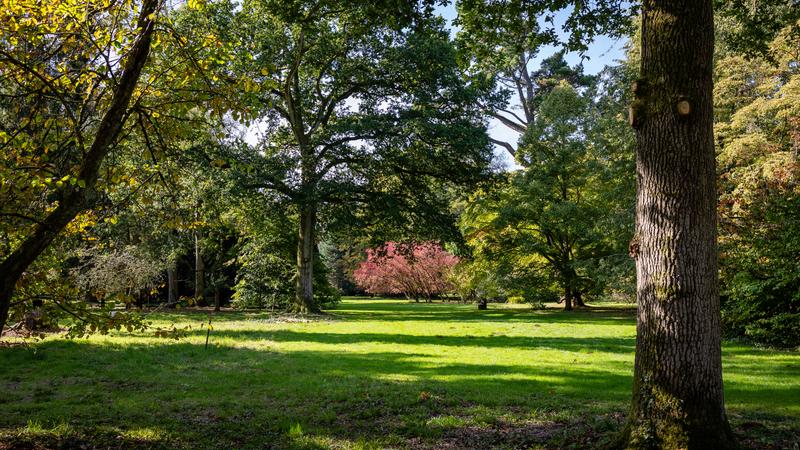Note: For specific information about tree care in Moore County, including local species, seasonal considerations, and regional challenges, be sure to read our guide on Tree Care in Moore County.
Introduction
Trees add beauty, shade, and value to any property. However, proper maintenance is essential to keep them healthy, safe, and aesthetically pleasing. This comprehensive guide will walk you through everything homeowners need to know about tree trimming – from understanding why it's necessary to knowing when to call in the professionals.
Checkout this video on Tree Trimming Basics
Learn the fundamentals of proper tree care in this short video
Why Tree Trimming Matters
Health Benefits
Regular trimming removes dead or diseased branches before they can harm the tree or spread problems to other plants. It also improves air circulation and sunlight penetration through the canopy, promoting overall tree health.
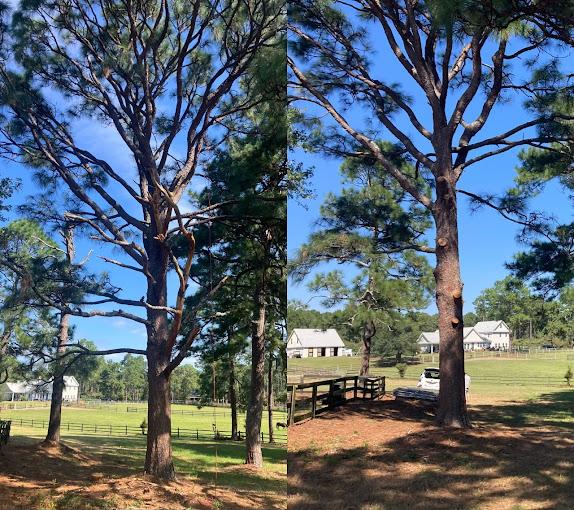
Before and after: Notice how the look of the tree is improved, and the tree can additionally seal where the dead branches were to prevent decay.
Safety Considerations
Overgrown branches can pose serious hazards. They may fall during storms, damage property, or cause injury. Low-hanging branches can obstruct walkways, driveways, and visibility for drivers. Branches growing near power lines present fire and electrocution risks.
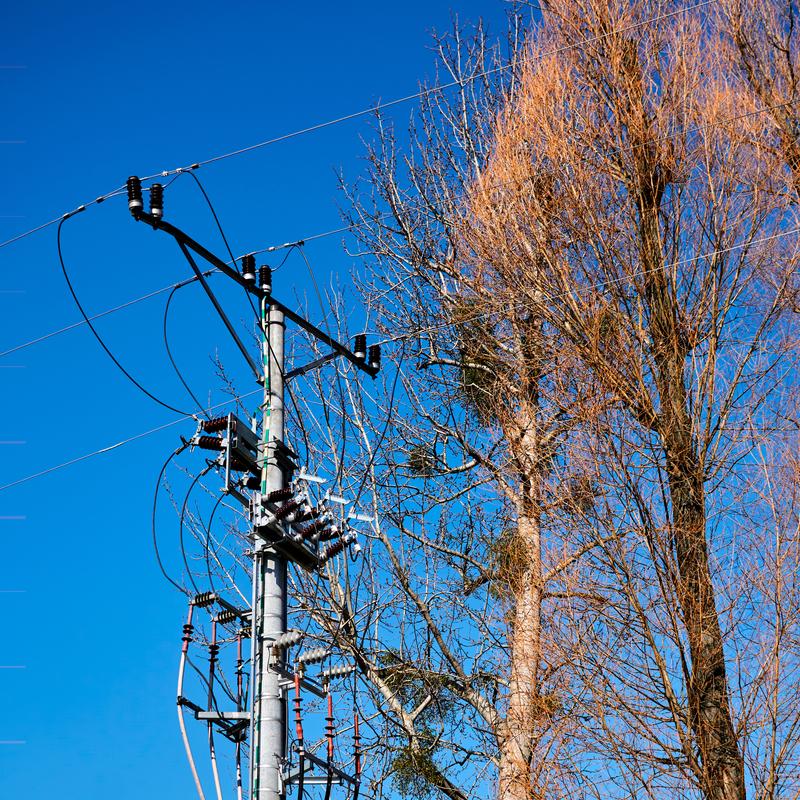
Branches growing near structures or power lines require immediate professional attention
Aesthetic Value
Well-maintained trees enhance your landscape's appearance and can increase property value. Strategic trimming shapes trees to complement your yard's design and allows for better views.
When to Trim Your Trees
Seasonal Guidelines
- Late Winter/Early Spring: Ideal time for most trees (when they're dormant)
- Summer: Light trimming and removal of problematic branches
- Fall: Avoid this season as cuts heal slower and fungi spread more easily
- After Flowering: For spring-flowering trees
Local Insight: For specific guidance on trimming common trees in Moore County like Longleaf Pine, Loblolly Pine, American Holly, Blackjack Oak, and Crepe Myrtle, see our Moore County Tree Care Guide or check out our annual tree care calendar: optimal times for different tree maintenance activities
Signs Your Trees Need Trimming
- Dead, dying, or diseased branches
- Crossed or rubbing branches
- V-shaped, weak branch unions
- Dense interior requiring thinning
- Branches touching structures or utility lines
- Excessive new growth after previous trimming
- Storm damage
DIY vs. Professional Tree Trimming
When Homeowners Can DIY
- Small, young trees
- Branches reachable from the ground
- Minor pruning and maintenance
- Simple tools required (hand pruners, loppers)
When to Call Professionals
- Large, mature trees
- High branches requiring climbing or ladders
- Branches near power lines
- Signs of disease or structural issues
- Trees close to structures
- Heavy limbs requiring specialized equipment
- After storm damage
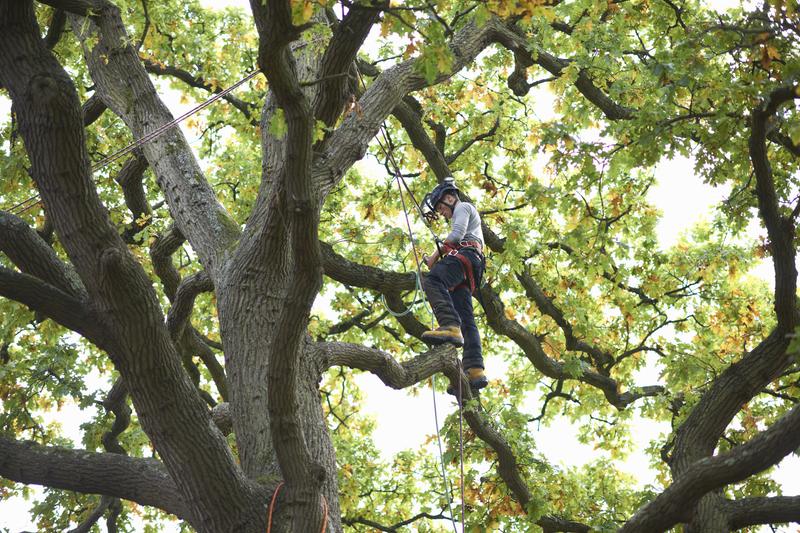
Our professional team has the equipment and expertise to safely handle large trees
Not Sure If You Need Professional Help?
Our certified arborists can assess your trees and provide expert recommendations
Get a Free ConsultationEssential Tree Trimming Tools
Basic Tools for Homeowners
- Hand pruners for branches up to ¾ inch
- Loppers for branches up to 1½ inches
- Pruning saw for branches up to 5 inches
- Pole pruner for higher branches
- Extension ladder (when necessary and safe)
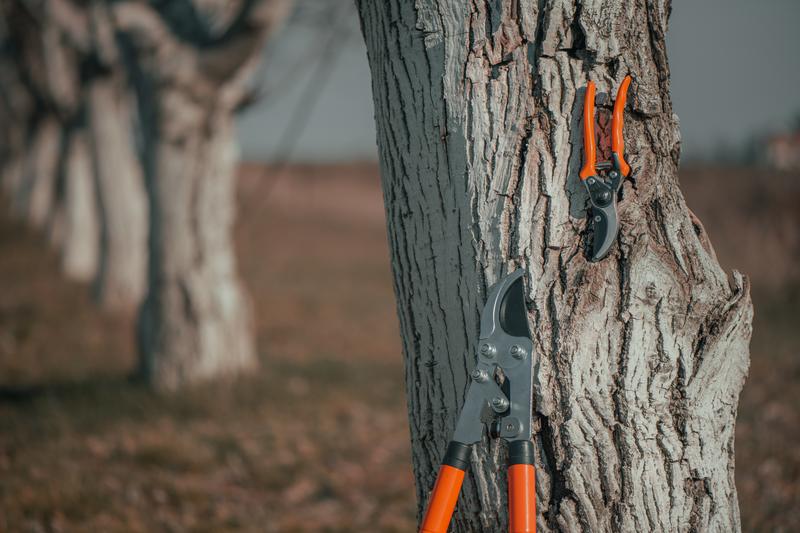
Basic tools for DIY tree maintenance (for jobs within your skill level)
Safety Equipment
- Gloves
- Safety glasses
- Hard hat (for larger jobs)
- Sturdy shoes with non-slip soles
Proper Tree Trimming Techniques
The Three-Cut Method
- First cut: Undercut a fair bit out from the trunk, about ⅓ through the branch
- Second cut: Cut through the branch 1-2 inches beyond the first cut
- Final cut: Remove the stub at the branch collar (swollen area where branch meets trunk)
Checkout this video on the three-cut method
The three-cut method prevents bark tearing and promotes faster healing
Trimming Best Practices
- Never remove more than 25% of a tree's canopy at once
- Make clean cuts at proper angles
- Don't leave stubs
- Avoid flush cuts that damage the branch collar
- Never top trees (cutting main branches back to stubs)
Common Trimming Mistakes to Avoid
- Cutting branches flush to the trunk
- Removing too many branches at once
- Using dull tools that crush rather than cut
- Improper cutting techniques causing bark tears
- Over-pruning that creates sunburn risk on exposed branches
- Topping trees (cutting main branches back to stubs)
Expert Advice: Our Moore County Tree Care Guide provides detailed information about pruning mistakes that are particularly problematic with local tree species. Learn about the CODIT (Compartmentalization Of Decay In Trees) process to understand how trees seal wounds.
Tree Trimming for Different Tree Types
Deciduous Trees
- Focus on structure during dormant seasons
- Remove crossing branches and water sprouts
- Thin crown to improve air circulation
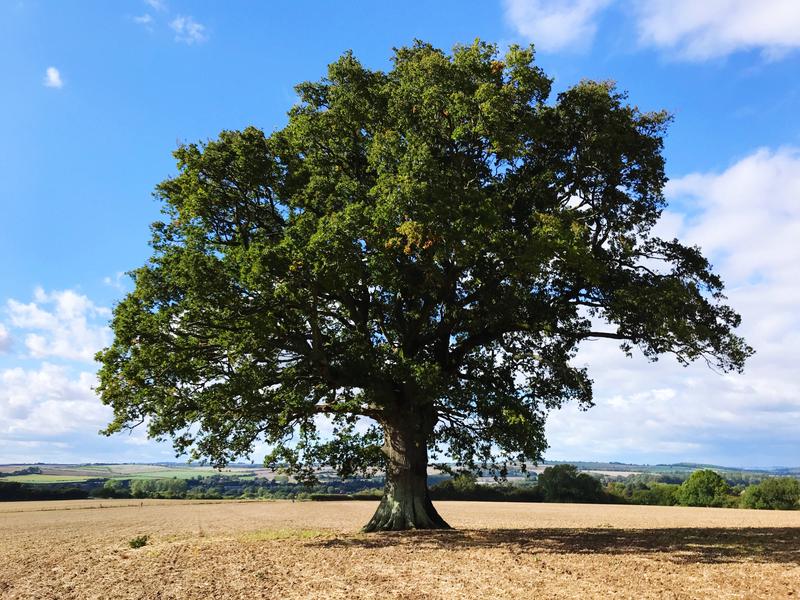
A properly maintained deciduous tree with good structure and spacing
Evergreen Trees
- Require minimal pruning compared to deciduous trees
- Focus on removing dead or damaged branches
- Shaping should maintain natural form
- Timing varies by specific species
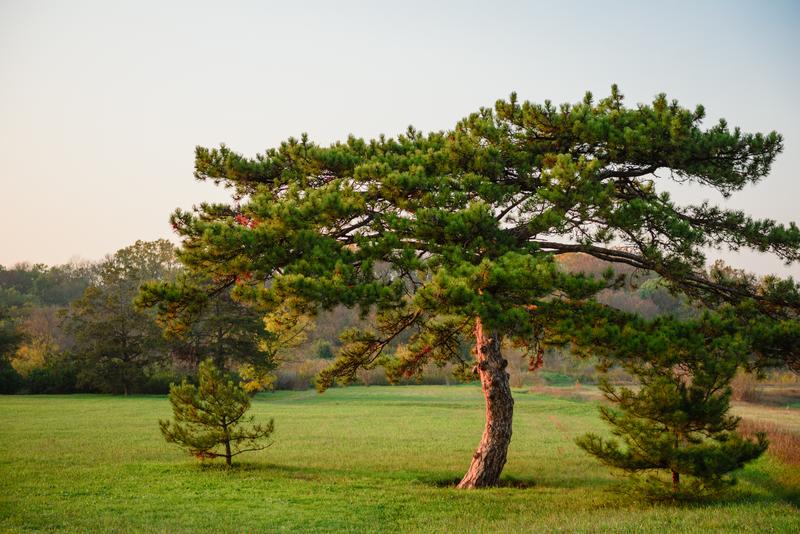
Evergreens require different trimming approaches than deciduous trees
Fruit Trees
- Prune to increase fruit production and ease harvesting
- Create open center or modified leader structure
- Remove suckers and water sprouts regularly
- Often requires annual maintenance
Special Trimming Situations
Young Tree Training
Focus on developing strong structure, maintain a single dominant leader, establish proper spacing of major branches, and remove competing leaders and branches with narrow angles.
Restoration Pruning
Gradual process for neglected or damaged trees. Focus on safety first, spread major pruning over several years, and may require professional assessment.
Vista Pruning
Selectively removing branches to improve views while maintaining tree health and opening sight lines. Often requires professional expertise to balance aesthetics and tree health.
After Trimming Care
Wound Treatment
Modern practice generally avoids wound dressings. Allow cuts to heal naturally and monitor for signs of disease or pests.
Soil Considerations: Moore County's predominantly sandy soils affect how trees recover after trimming. Learn about proper watering, fertilization, and mulching techniques specific to our sandy soil conditions in our Local Tree Care Guide.
Disposal of Trimmed Material
- Chipping for mulch
- Community yard waste programs
- Composting smaller branches
- Firewood (for appropriate species)
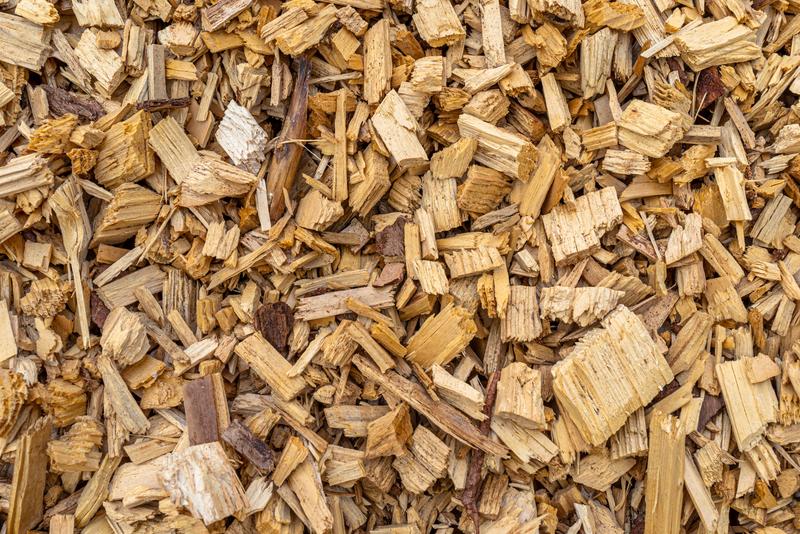
Chipped branches make excellent mulch for your landscape
Ongoing Maintenance
Regular inspections, follow-up trimming schedule, and mulching and proper watering to reduce stress.
Environmental Considerations
Wildlife Habitat
Consider nesting birds when timing trimming, leave some dead branches when safe and appropriate, and balance tree health with habitat value.
Tree Trimming Regulations
Check local ordinances before major trimming. Special permits may be required for protected species, and HOA restrictions may apply in some neighborhoods.
When to Seek Professional Help
Warning Signs
- Extensive dead wood
- Signs of internal decay
- Cracks or splits in major limbs
- Leaning trees
- Any work near utility lines
- Advanced disease or pest problems
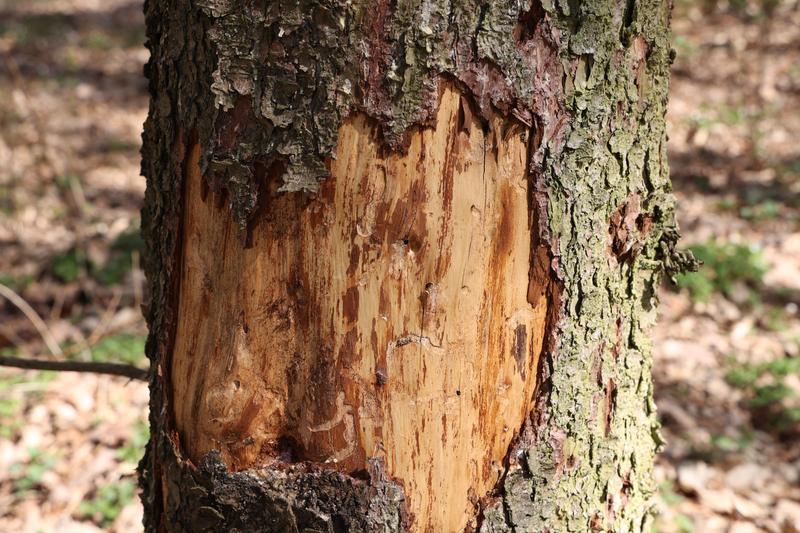
These warning signs indicate your tree needs professional attention
Choosing a Tree Service
- Look for ISA Certified Arborists©
- Verify insurance and credentials
- Get multiple estimates
- Check references and reviews
- Ask about cleanup and disposal
Ready for Professional Tree Care?
Our team of arborists provides safe, effective tree trimming services
Request a Free QuoteConclusion
Proper tree trimming is an investment in your property's safety, beauty, and value. While some maintenance can be handled by homeowners, knowing when to call in professionals is crucial. By following the guidelines in this comprehensive guide, you can ensure your trees remain healthy assets to your property for years to come.
Moore County Residents: For a complete approach to tree care in our area, use this guide in conjunction with our Tree Care in Moore County article, which addresses local species, soil conditions, common pests specific to our region, and seasonal considerations for our climate.
FAQs About Tree Trimming
- How often should I trim my trees?
Most mature trees benefit from trimming every 3-5 years, while young trees may need more frequent attention. Fruit trees typically require annual pruning.
- Will trimming hurt my tree?
When done properly, trimming benefits trees. Improper techniques, however, can cause lasting damage. Follow guidelines or consult professionals when unsure.
- What's the difference between trimming and pruning?
Trimming generally refers to cutting back overgrown branches, while pruning is more selective and done to improve tree health and structure. In practice, the terms are often used interchangeably.
- Can I trim my trees in summer?
Light trimming can be done in summer, but it's best to avoid major trimming during growing season. Late winter/early spring is ideal for most trees.
- How do I know if my tree is diseased?
Signs include unusual leaf drop, discolored leaves, cankers on branches, fungal growth, peeling bark, and dead branches. A certified arborist can provide proper diagnosis.

